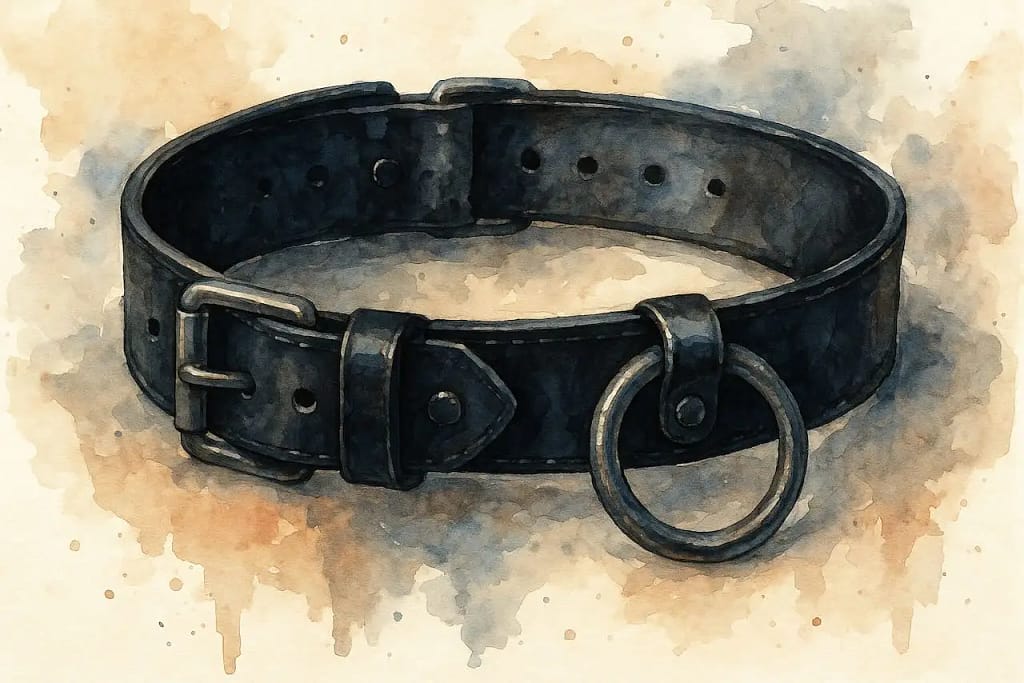Sub – Submission – Devotion: What does it really mean to be submissive? A comprehensive guide to the role of the sub in BDSM, femdom, and D/s relationships – with many facets, myths, and practical tips.
New to femdom and BDSM? Start here: Femdom Guide, BDSM Guide and Lady Sas Femdom Library.
The sub is kneeling naked and upright in front of his Mistress. His gaze is lowered in submission, his legs slightly spread. His hands rest on his thighs, palms facing up. “Greet me, slave,” demands the Mistress. Instantly, the sub starts kissing the high heel that his Mistress has placed in front of him. She watches with satisfaction as the sub worships her devotedly and passionately. She sees a man who consciously decides to give up control. Not out of weakness, but from a deep inner strength that allows him to be vulnerable.
This is where the world of submission begins. When people hear “sub,” they often think of obedience, weakness, passivity. But the reality is far more complex, multi-layered and – yes – powerful. Because a sub is not someone who has no power. A sub is someone who consciously gives their power away.
In this article, we explore many facets of submission: What is a sub in BDSM? What types of subs are there? How do male and female subs differ? What happens psychologically when you surrender? And how can you live submission safely, fulfillingly, and authentically?
What is a sub in BDSM? Definition and basics
Sub is short for submissive. In BDSM and D/s contexts (Dominance/submission), the term describes a person who, within a power-exchange dynamic, takes the receiving, following, surrendered role. Important: A sub can be male or female.
A sub in BDSM gives up control voluntarily – to a dominant person (Dom, Dominatrix, Top, Mistress, Master). This control can extend to different areas: the body, decisions, sexual activities, daily routines, or emotional leadership.
Important to understand:
- Submission is voluntary: A sub consciously chooses this role. There is no real submission without consent. Anything else would be slavery – illegal and despicable.
- Submission is not weakness: It takes courage, self-awareness, and trust to give up control.
- Submission is diverse: There are countless ways to be submissive – from soft to intense, from bedroom-only to 24/7, meaning 24 hours a day, 7 days a week.
- Submission does not mean “anything goes”: Subs have boundaries, desires, and the right to respect. If a sub claims to have no limits, it mainly shows one thing: little experience. Every sub has limits – and that is good and important.
The psychology of submission – Why people are submissive
Why are some people drawn to submission? The answer is as individual as the people themselves. But there are recurring psychological patterns.
Giving up control as liberation
Many subs in BDSM experience their everyday lives as controlled, structured, and full of responsibility. They constantly make decisions – at work, in the family, in life. In submission, they can hand over this burden. They no longer have to think, plan, or lead. They are allowed to simply be and follow. Switch the brain off, switch the scene on.
This does not contradict being strong in everyday life. On the contrary: Quite often, people who carry a lot of responsibility in their “normal” lives find deep fulfillment in submission. Is that a cliché? Maybe – but it’s a very common pattern. Many subs are successful in life. Only from their inner strength can they allow themselves to be vulnerable. Subs are not weaklings. Quite the opposite.
Trust and surrender
Submission is built on trust. The sub trusts that the dominant partner will handle the given power responsibly. This deep trust creates an intense emotional bond and can lead to a feeling of safety and protection.
For many subs in BDSM, this is the core of it all: being able to let go without being afraid.
Endorphins, flow, and subspace
During intense BDSM sessions, subs can enter an altered state of consciousness called subspace. Thanks to the release of endorphins, adrenaline, and other neurotransmitters, they experience a sense of trance, euphoria, and deep calm. Pain is perceived as less intense, the ego steps back, and the sub is fully present in the moment.
Many describe this state as deeply fulfilling, almost meditative. Learn more in our article “Pleasure Pain in Impact Play“, which explains what happens in the body during BDSM.
Identity and self-expression
For some people, submission is not just a role they step into – it’s part of their identity. They feel most authentic and alive as a sub. Submission then is not a mask but a form of self-expression.
Different types of subs
Not every sub is the same. There are many different expressions of submission – depending on personality, preferences, and dynamic. Here are some of the most common types:
The service sub
Service subs find fulfillment in serving. They love completing tasks that bring joy or ease to the dominant partner: cleaning, massages, foot worship, cooking, organizing. Their focus is less on pain or humiliation and more on the value they provide.
The masochist
Masochistic subs enjoy pain – whether through impact play, wax, needles, electroplay, or other techniques. For them, physical pain is a path into subspace, to endorphins and deep surrender. Pain turns into pleasure.
The brat
Brats are rebellious subs. They tease, provoke, test boundaries, demand attention, and enjoy the punishment that follows. Brats want to “earn” dominance and love the dance between resistance and submission.
The degradee sub
For degradees, humiliation is the key to arousal. They enjoy being verbally degraded, insulted, objectified, or humiliated. Important: This is consensual and actively desired by the sub. Note: The term “degradee” is not very widespread in the German-speaking scene but describes this type well.
The pet slave
Pets take on the role of an animal in pet play (dog, cat, pony, etc.). Pets often live in more intense, structured D/s relationships with clear rules, protocols, and a high degree of devotion.
The rope bunny
Rope bunnies love being tied up. For them, bondage is not just a means to an end, but often an aesthetic, emotional, and physical pleasure in its own right.
Note: These categories are not mutually exclusive. Many subs embody several of these aspects at once.

Being a male sub in the femdom world
In the context of femdom (female domination), the male sub plays a central role. The woman takes on the dominant position while the man submits. See also our Femdom Guide, where we explore this dynamic in depth. This can take many forms:
- Chastity: The man wears a chastity cage and is only allowed to experience sexual pleasure with his Mistress’s permission.
- Sissification: The sub is feminized, wears feminine clothing, and takes on a submissive, often humiliating role. A well-known, popular example is Natalie Mars. Learn more about her in our article: Natalie Mars – The secret of the trans icon.
- Cuckolding: The sub accepts that his Mistress has sexual relationships with other men. She openly “makes him a cuckold” and has fun with her lovers (bulls). This humiliation turns the cuckold on. More about cuckolding.
- Service, duties, butler and driver: Housework, foot worship, financial support (findom).
- Masochism: Masochists are aroused by pain – for example through spanking, canes, crops, or paddles.
Male subs break with traditional gender roles. They show that masculinity and submission are not opposites. On the contrary: It takes courage to go against social expectations and live your own desires.
In intense femdom–sub dynamics, the relationship is often defined in written slave contracts. On our site, for example, you can find the slave contract between Lady Sas and her sub Toytoy.

Being a female sub in the BDSM world
Female subs are also very common in the BDSM world – often in relationships with male Doms (maledom). Again, the range is wide: from gentle guidance and daddy–dom dynamics to more intense master/slave relationships.
Female subs often report that they find safety, structure, and emotional closeness in submission. Surrendering to a trusted Dom can be deeply fulfilling for them.
Important: Female submission must never be confused with outdated gender roles or oppression. BDSM submission is voluntary, conscious, and revocable at any time.
There is also a female sub on our team. Learn more about our sub jO.
Bedroom-only sub or 24/7 slave? How far can submission go?
One of the most important questions for every sub: How far should submission go? Only in the bedroom? Or also in everyday life?
Bedroom-only sub
Many couples live their D/s dynamic exclusively in a sexual context. During a session, the sub is submissive; afterward, they return to an equal partnership. This form of submission is clearly defined, manageable, and perfect for many couples.
Lifestyle D/s sub
Here, the power dynamic extends into everyday life. Through rules, rituals, and protocols, the sub might ask permission for certain things or complete daily tasks for the Dom. The intensity varies: from light structures to more demanding arrangements.
24/7 and TPE (Total Power Exchange)
In 24/7 D/s relationships, the couple lives the power dynamic around the clock. In TPE (Total Power Exchange), the sub gives up almost all decision-making power – from clothing and finances to social contacts. This requires an extremely high level of trust, communication, and responsibility on both sides.
Learn more about different forms of female-led relationships.
Important:
There is no “right” or “wrong.” Any form of submission is valid as long as it is consensual and fulfilling for both sides. Bedroom-only is just as legitimate as 24/7.

Communication and boundaries – The foundation of any submission
Submission may sound like “letting yourself be led,” but the reality is: good submission requires excellent communication.
Before the session: Negotiation between Top and sub
Before you start, Dom and sub should discuss:
- Hard limits: What is absolutely off the table?
- Soft limits: What might be possible with caution?
- Desires: What does the sub want to experience?
- Safewords: Words like “red” (stop immediately) or “yellow” (slow down).
During the session: Check-ins by the Dom or Mistress
Good Doms check in regularly: “How are you doing? Everything okay? Do you need anything?” Even when the sub is in subspace, safety remains the top priority.
After the session: Aftercare by the Dom or Mistress
After intense sessions, the sub needs aftercare: closeness, warmth, water, rest, affectionate words. The body needs to “land” again and process the endorphins. Good aftercare helps prevent subdrop (an emotional low after a scene).
Myths about subs – and the truth behind them
There are many misconceptions and stereotypes around submission. Time to clear up some of the most common ones:
Myth: “Subs are weak”
Reality: Submission requires tremendous strength. It takes courage to show vulnerability, offer trust, and let go. Many subs are strong, confident personalities in everyday life.
Myth: “Subs are abused”
Reality: In healthy BDSM relationships, everything is consensual. The sub always has the right to say no. Real dominance respects boundaries.
Myth: “Subs have no power”
Reality: In fact, the sub has a great deal of power. They decide who receives control and how far it goes. The sub is the keyholder of the dynamic.
Myth: “Subs are passive”
Reality: Good subs are active: they communicate, give feedback, show reactions, and serve consciously. Submission is not passivity – it is active devotion.
How do you know if you are a sub in BDSM?
Many people discover their submissive side over time. Some possible signs:
- You are aroused by the idea of giving up control
- You enjoy following instructions or serving
- You fantasize about dominance, bondage, or punishment
- You long to be “held” or guided
- You feel fulfilled when you make someone else happy
If you recognize yourself in this: That’s completely normal and okay. Submission is a legitimate, healthy sexual orientation.
Safety for subs in BDSM– What you should pay attention to.
As a sub, you hand over power. That makes it even more important that you feel safe. Here are the most important rules:
- Trust your gut: If something feels wrong, it probably is.
- Boundaries are sacred: A good Dom always respects your limits. Anyone who pressures you is not a good Dom.
- SSC or RACK: Safe, Sane, Consensual or Risk-Aware Consensual Kink.
- Get to know your Dom: Build trust before you dive into intense scenes.
- Educate yourself: The more you know about BDSM, safety, and your own needs, the better.
Do you enjoy articles like this? Join the Inner Circle Newsletter. Get interviews, tips, and insights conveniently via email.
Sub, be shaped and challenged.
Experience your personal 14-day program of submission, discipline, and devotion. In this exceptional, interactive training, Lady Sas guides you step by step into your new role as a slave—with daily tasks, rituals, and psychological insights.

Learn what real Femdom training means. Let yourself be shaped into a sub. And intentionally increase your chances of being allowed to serve a private Mistress long-term at her feet. Rated ⭐️⭐️⭐️⭐️ 4.5 out of 5 stars on Amazon (7 ratings).

Continue your training on a higher level. Private Femdom Lady Sas explains in this book how you can win over even the most demanding Mistresses. Develop into a valuable sub. Rated ⭐️⭐️⭐️⭐️⭐️ 5 out of 5 stars on Amazon (1 rating).
Prefer listening over reading? Discover our audiobooks. 🎧
Experience our audiobooks. Immersive, sensual, and expertly narrated journeys into the world of Femdom you can enjoy anytime, anywhere.
Who’s writing Lady-Sas.com?

Hi, we are Lady Sas and Lady Victoria, two private Femdoms from Frankfurt am Main. We are experts and authors on the topics of Femdom, BDSM, FLR, cuckolding, chastity, and sissification.
With Lady-Sas.com, we want to encourage private women to discover their dominance and live out their desires. We also want to encourage submissive men to feel comfortable in their role.
→ Femdom Library → BDSM Guide → Tease and Denial Guide
FAQ – What is a sub in BDSM?
What is a sub in BDSM?
A sub in BDSM is a person who voluntarily takes the receiving, following, surrendered role in a power-exchange dynamic. They hand over a defined amount of control to a dominant partner – for example a Dom, Dominatrix, Top, Mistress, or Master – in scenes, in the bedroom, or sometimes in everyday life.
Is being a sub in BDSM a sign of weakness?
No. Submission requires strength, self-knowledge, and courage. A sub in BDSM consciously chooses to give up control and trusts their dominant partner. Many subs are very responsible, successful people in everyday life and experience submission as a place to let go and recharge.
Can anyone become a sub, or is it a fixed orientation?
For some, being a sub feels like a deep part of their personality or sexual orientation. Others discover submission later in life or enjoy it only in certain contexts. You don’t have to “qualify” as a sub – if consensual power exchange and surrender turn you on and feel right, that’s valid.
What types of subs are there in BDSM?
There are many types, and they often overlap. Common examples include service subs (focused on serving and helping), masochistic subs (who enjoy pain and intense sensations), brats (rebellious, teasing subs), degradee subs (who enjoy consensual humiliation), pet subs in pet play, and rope bunnies who love bondage.
How do I know if I might be a sub in BDSM?
Signs can include being aroused by giving up control, enjoying following instructions or serving, fantasizing about dominance, bondage, or punishment, longing to be guided or “held,” and feeling fulfilled when you make someone else happy. If that resonates and feels good, you may have a submissive side.
What is subspace, and why do subs talk about it?
Subspace is an altered state that some subs experience during intense BDSM play. Because of endorphins and adrenaline, they may feel floaty, calm, euphoric, or in a light trance. Pain and time can feel different. Subspace can be deeply pleasurable – but it also means the sub needs careful monitoring and good aftercare.
Can you be both a Dom and a sub?
Yes. People who enjoy both roles are called switches. Depending on partner, mood, and situation, they might dominate in one dynamic and submit in another. Being a switch doesn’t make you “less real” as a Dom or as a sub.
Does a sub in BDSM always have to obey?
No. Obedience is part of the erotic game, not a moral or legal obligation. A sub always has the right to say no, to use a safeword, or to end a scene. Healthy dominance respects limits and never punishes someone for protecting their boundaries.
Is submission compatible with feminism and modern gender roles?
Yes. Feminism is about choice and self-determination. If a woman (or anyone) freely chooses consensual submission, that decision is compatible with feminist values. Coerced submission is never okay; chosen submission can be empowering and deeply fulfilling.
What safety rules should subs in BDSM follow?
Important basics include: know your limits, discuss hard and soft limits in advance, agree on safewords, educate yourself about BDSM and risks, get to know your Dom before intense play, and always trust your gut. If someone ignores your boundaries or pressures you, walk away – that is not responsible dominance.





